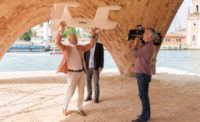Norman Foster Presented with Architecture Sarasota’s Second-Annual Hiss Award

Norman Foster accepts the 2024 Philip Hanson Hiss Award at a March 23 award ceremony and celebration in Sarasota. Photo by Kelsey Long/Olive Grey Photography, courtesy Architecture Sarasota
“I always tell people who work with me, ‘I wouldn’t ask you to do anything I wouldn’t do,” says Marty Hylton III. “But then I tell them, ‘The thing is, I’ll do anything.’” It’s an attitude that’s served him well: as the first-ever president of Florida preservation-and-educational nonprofit Architecture Sarasota, Hylton has spent the better part of two years using his singular sense of drive to turn the nascent organization into a regional force, fighting to save local landmarks and spread awareness of the sunny coastal city’s unique cultural heritage. This month, his efforts—and those of his no-less-motivated colleagues—got a big ovation.
On March 21, Architecture Sarasota welcomed guests from near and far for the unveiling of a new exhibition chronicling the city’s Modernist history; days later, Hylton and company presented the second-annual Philip Hanson Hiss Award, recognizing an architect whose work extends the tradition of the postwar Sarasota School into contemporary practice. The honoree this year (following the inaugural recipient in 2023, Toshiko Mori): Lord Norman Foster, who was on the scene to deliver a lecture on his work and to receive the prize.

1

2

3
Architecture Sarasota president Marty Hylton speaks at the opening of Moderns That Matter at the McCulloch Pavilion in downtown Sarasota (1); interpretive panels (2), models (3), and more highlight 100-plus notable architectural sites in and around town. Photos by Kelsey Long/Olive Grey Photography, courtesy Architecture Sarasota
The first item on the agenda, the show at Architecture Sarasota’s downtown headquarters, demonstrated the remarkable breadth of Sarasota’s design legacy. Moderns That Matter: Sarasota 100 represents the culmination of a years-long research project, identifying and documenting local landmarks from the early-20th century to today. The name of the exhibition is somewhat misleading: “It’s actually a lot more than a hundred,” notes Hylton, who economized by cataloging multiple projects by the same designer under a single heading. This was the method deployed for the architect whose name is most often associated with the city, and whose projects—as they appear on the giant map that accompanies Moderns That Matter’s interpretive panels—appear more often than any other: Paul Rudolph, who completed some twenty-odd buildings in Sarasota during the 1950s and 60s, establishing a reputation that would carry him to national and international renown.


Photos by Kelsey Long/Olive Grey Photography, courtesy Archiecture Sarasota
The Rudolph connection was the chief rationale for giving the Hiss prize (named for a local developer who commissioned many of Rudolph’s earliest projects) to Foster. “I met him on my first day at the Yale School of Architecture in 1961,” Foster recalled, speaking prior to the award lecture. “He was intense, passionate, fired by an idea of architecture.” The Pritzker Prize winner’s lecture took Sarasotans through a project-by-project tour of his London-based practice over the course of the last two decades—and though it made little explicit reference to his former teacher’s buildings as such, anyone familiar with the work of both could connect the dots, Rudolph’s taste for structural invention and emphatic form-making seeming an obvious precedent to his student’s subsequent projects around the world.

Butterfield House (2016), designed by Foster’s Yale peer Carl Abbott, served as venue for the award festivities along with a neighboring residence, the Guy Peterson–designed Companion House (2007). Visible across the canal is Paul Rudolph and Ralph Twitchell’s Cocoon House (1950). Photo © Leonardo Lunardi
More surprising even for some seasoned architecture lovers was the sheer abundance of outstanding buildings around Sarasota—not just from Rudolph, but from contemporaries like Ralph Twitchell and Victor Lundy, as well as by 21st-century practitioners like Jonathan Parks and Damien Blumetti—as evidenced both in the Moderns That Matter exhibition, and on the streets and boat-lined canals that snake through the bayfront community. “People think the Sarasota School was something that happened in the past and that it’s over now,” says Hylton. “It isn’t.” As if to prove the point, the awards dinner was hosted at a large house created by Guy Peterson in 2007, wrapped gently around the tiny 1948 Revere Quality House designed by Rudolph and Twitchell. With Rudolph’s Cocoon House just visible across the nearby waterway, Foster took the stage to accept the prize from Hylton, who appeared to relax for the first time all week (or perhaps in two years) and enjoy the applause of an appreciative Sarasota crowd.

Rudolph and Twitchell’s Revere Quality House (1949). Photo © Wayne Eastep

-min.jpg?height=200&t=1680140864&width=200)
